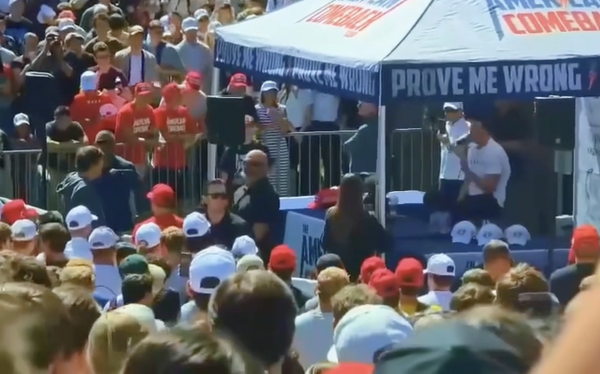The Federal Reserve announced a 75-basis-point rate hike for the first time since 1994 as it combats the biggest inflation outbreak in 40 years with increased urgency. With the latest data pointing to greater risk that high inflation may become entrenched, policymakers now expect to raise the Fed's key interest rate all the way to 3.8%.
The Dow Jones Industrial Average, after an initial wobble, rose strongly during Fed chief Jerome Powell's post-meeting news conference before gains somewhat by the close.
Powell said the Fed had expected inflation to be "flattening out." With May's CPI coming in even hotter, Powell said policymakers thought "strong action was warranted."
He also said that survey data showing that consumer inflation expectations are rising pushed the Fed to move faster.
Policymakers are likely to decide between a half-point hike and a 75-basis-point move at the July meeting, Powell said. Markets had been betting strongly on another supersized hike.
"There's no sign of a broader slowdown in the economy," Powell said, though he did note some softening in business investment. He continues to see the U.S. economy as being "well-positioned to deal with higher interest rate."
Powell Broadly Addressed Financial Markets
What does Powell make of the recent bloodletting that has seen the S&P 500 fall into bear-market territory while the Dow has shed 8.5% over five straight down days?
Powell wasn't asked that directly, but he made some related comments.
"We've seen financial conditions tighten and appropriately so," Powell said. That tightening should help bring demand into line with supply, he said.
Asked whether the Fed's balance-sheet tightening, also known as quantitative tightening, was a source of market volatility and illiquidity, Powell said simply, "Markets seem to be OK with it."
Fed Rate Hike
The Fed announced a hike in its key overnight interbank lending rate to a target range of 1.5%-1.75%. The last time the Fed hiked by so much at a single meeting was in November 1994. Yet the pace of monetary tightening is even faster now, since the rate hikes are being accompanied by the shrinking of the Fed's balance sheet.
Rate-Hike Outlook
Economic projections issued by the Fed, reflecting the median forecast of individual policymakers, now show the key policy rate rising to 3.4% this year and 3.8% in 2023, then easing to 3.4% in 2024.
In projections issued in March, the Fed rate was seen rising only to 1.9% this year and reaching 2.8% next.
However, the new set of projections imply fewer hikes than the market has priced in. CME Group's FedWatch page shows markets expect the key Fed rate to rise to a range of 3.75%-4% by the end of this year.
The Fed's urgency was surely heightened by Friday's May CPI report, which showed headline inflation hitting a 40-year-high of 8.6%. Surging food and energy prices are part of the reason. But Fed officials may be particularly troubled by prices for nonenergy services rising 5.2%, the fastest pace in 30 years. That includes big spending categories like rent and health care.
As a result of the ongoing bout of inflation, the University of Michigan's June survey showed that consumers now expect inflation of 3.3% over the next 5 to 10 years, up from 3% a month earlier. Since psychology plays a big part in inflation dynamics, rising inflation expectations add pressure on the Fed to act forcefully.
Policymakers now see the Fed's preferred inflation gauge, based on the core personal consumption expenditures price index, easing to 4.3% in the fourth quarter, 2.7% by the end of 2023 and 2.3% in 2024.
Officials project that the unemployment rate will end this year at 3.7%, 2023 at 3.9% and 2024 at 4.1%. That compares to 3.6% currently.
Powell said he would consider 2% inflation and 4.1% unemployment "a successful outcome."
When To Sell A Stock: Cutting Losses Short Is The First Rule
Dow Jones, Treasury Yield Reaction
After Powell spoke, the Dow Jones surged more than 2% intraday before settling for a 1% gain. The S&P 500 added 1.5% and the Nasdaq 2.5%.
As of Tuesday's close, the Dow was nearing bear market territory, down 17.5% from its all-time closing high. The S&P 500 had fallen 22.1% and the Nasdaq 32.6%.
Be sure to read The Big Picture every day to stay in sync with the market direction and what it means for your trading decisions.
After the Fed policy statement, the 10-year Treasury yield skidded to 3.31% from Tuesday's 11-year high of 3.48%.
CPI Inflation Rate Shock Jolts Fed Policy Outlook
Federal Reserve Balance-Sheet Tightening
On May 4, the Fed announced it would begin gradually unwinding much of its $4.5 billion in pandemic-era purchases of Treasuries and government-backed mortgage securities starting in June. As those securities mature, the Fed has been reinvesting all of the principal, but officials will begin letting that some of that principal run off. That balance sheet runoff went into effect today, when the Fed began to reinvest principal received in June.
The pace of balance-sheet tightening will ramp up to a monthly pace of $95 billion over three months. Officials have said that the cumulative effect after a couple of years will approximate an additional half-point rate hike.
The Federal Reserve's 'Most Anticipated' Recession In History May Be Coming
No Quick Fix For Dow Jones
This isn't the first time that the Fed has provoked a steep market pullback by tightening with both fists — hiking rates while shrinking its balance sheet. But the differences between now and the previous episode, at the end of 2018, are telling.
Last time around, all it took was a mere flirtation with a bear market — major index declines of close to 20% — for the Fed to begin to reverse course in a matter of days. First, policymakers hit the brakes on rate hikes and balance-sheet tightening. But the next fall, they were cutting rates and buying more assets.
This time, despite the Dow being close to a bear market and the S&P 500 and Nasdaq already across that threshold, policymakers are accelerating their tightening plans.
Federal Reserve policy works on the economy indirectly, by influencing financial conditions — a combination of market interest rates, asset valuations, credit spreads and the ability of companies to raise capital. If the Fed is urgently working to cool demand, policymakers won't want household wealth to recoup much of this year's losses. That implies a fairly low ceiling for any near-term stock rally.







